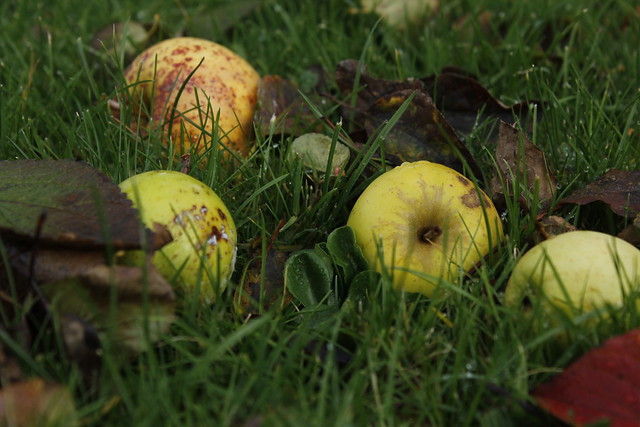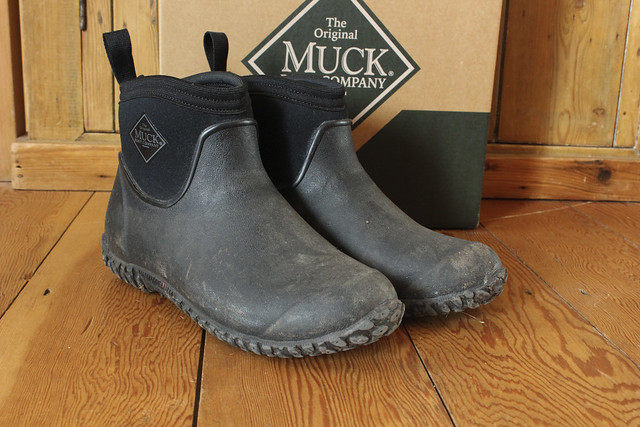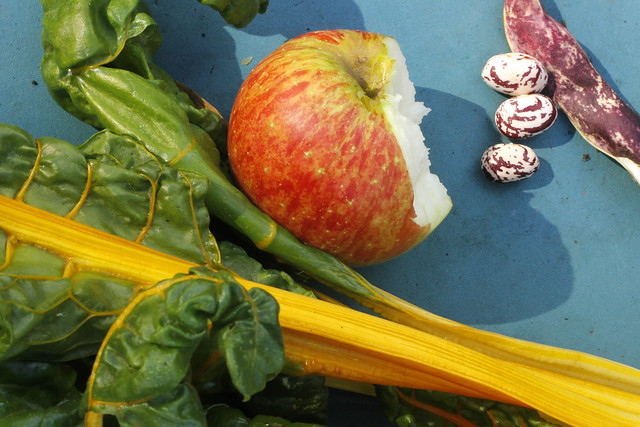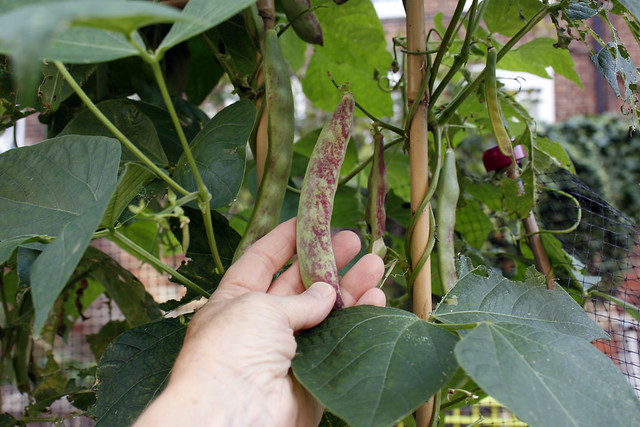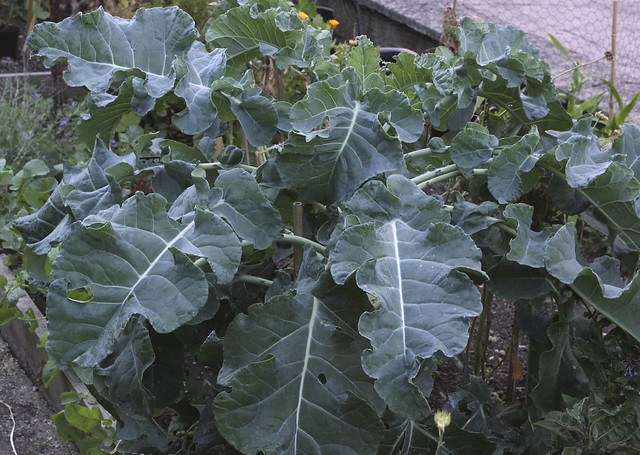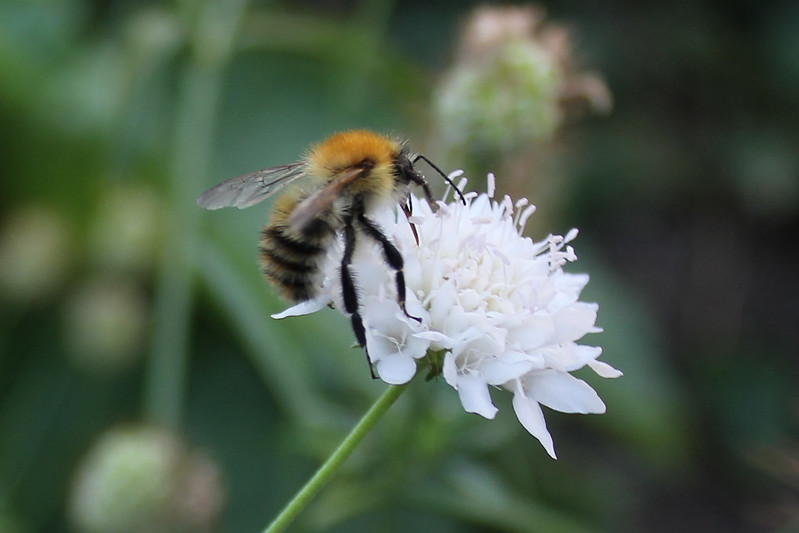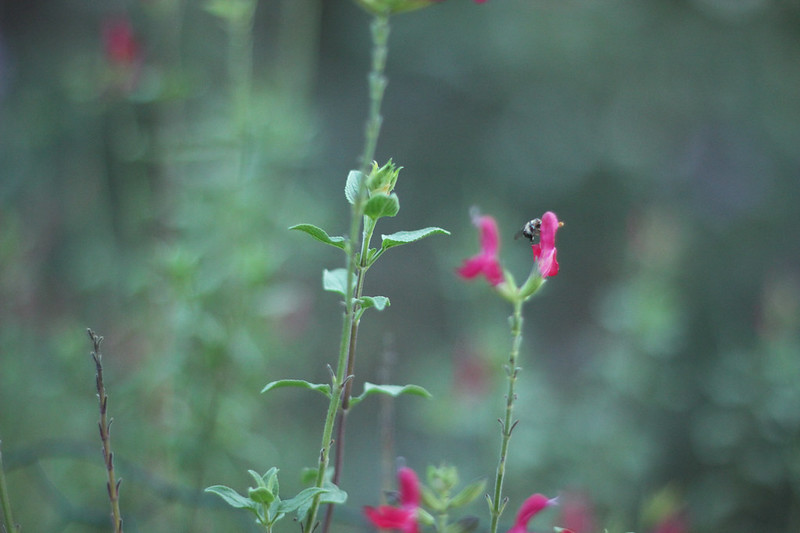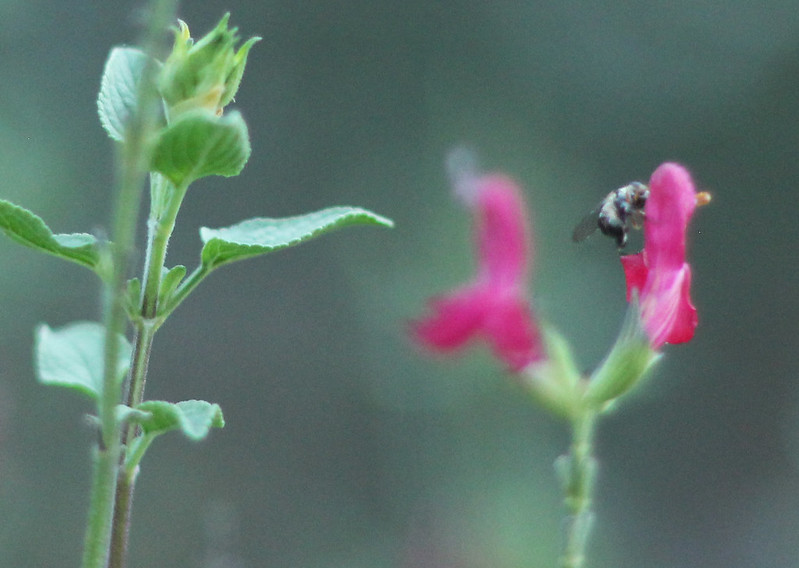Are blotched apples safe to eat? I found out the answer is yes, and cooked up a batch for winter use.
Given that the meagre fruit from my veg patch apple trees has long gone, I could hardly believe my eyes when I walked into my niece's garden the weekend before last; at the far far end of the garden, the branches of the two eating apple trees were still weighed down with fruit. Not only that but the grass all around was littered with windfalls so the fruit was definitely ready for picking. Nature's bounty waiting to be used ...
25 Nov 2016
21 Nov 2016
A glimpse of the Chiltern Hills
What would make your perfect weekend? There's always something calling for my attention so the ideal weekend for me is when I make time to step away from normal life and enjoy something different.
It's not often that a few days come together as faultlessly as they did on the weekend before last. For a start I had a free Friday (always a good start). I planned three days of bliss with one day of gardening, one day at an RHS show and Sunday walking in the Oxfordshire countryside with family. With sun:rain:sun weather, I couldn't have wished for better.
Labels:
Chiltern Hills,
walk,
woodland
Posted by
Caro
at
10:34
17 Nov 2016
RHS London Urban Garden Show 2016
Hoping that the weather forecast was accurate for the weekend, on my agenda for a very wet Saturday was the new Urban Garden show from RHS London. What's that? A gardener hoping for a wet Saturday? I had my reasons; I wanted to get along to the show without having to choose between indoors or outside. The pull to be outside on a sunny day is strong.
As you all know, I do love a gardening show, especially when it's new. It's good news to see the London shows being extended again with this new addition for small space gardeners. (The early summer Rose Show was added in 2015.) We've recently had the Harvest Festival and Shades of Autumn shows at either end of October, the Christmas Show is still to come (17th/18th December) and now the Urban Garden Show has been sandwiched into November. The RHS Westminster shows that I've been to in the past have allocated a lot of space for the usual retailers and plant displays, with (I'm sorry to say) an uninspiring small café area squeezed into the gallery. Would this one be any different? Happily, yes, I believe so; indications are good. The plant displays were still much in evidence - amazing cactus and tropical plant installations by Cityscapes (see top photo), styled by garden designers Jarman Murphy - and a new host of retailers too. Entrance to the show was by navigating a path through a tropical jungle of potted plants, creating a contemporary ambience which matched the theme of urban and indoor gardens.
 |
| Cakes with fruit, veg, flowers and herbs ... |
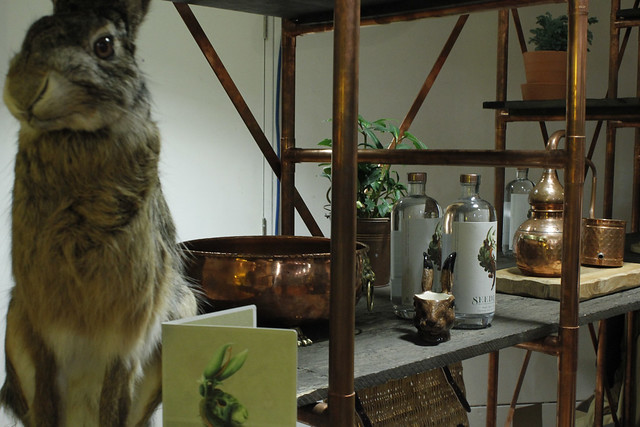 |
| Surprisingly delicious non alcoholic spirits from Seedlip. The bunny approves. |
Reluctantly leaving the cake and delicious eats to one side for the moment, the show was all about encouraging and inspiring people to garden, even if space allows for just the one tiny plant. Preferably stylish and in a funky pot or glass bauble. That might sound a tad cynical but actually the show was visually rather exciting. Smaller, nicely understated and with lots of really good artisan eats (vegan or otherwise) and drinks on offer and, crucially, the space to comfortably take a seat and enjoy your food. We gardeners like to linger over a cup of tea and a good slice of cake.
 |
| A cactus retailer named Prick seemed very popular! |
The show would have been sadly lacking if it was only about shopping but there was also an excellent programme of talks and workshops - and advice from the RHS On The Road campervan. There was a very tempting sounding 'behind the scenes' tour of the Lindley Library exhibition 'The City Gardener' but, silly me, I stupidly didn't realise that it had to be booked in advance; disappointment levels were high and lessons learned. This time all went to plan as I got to the show in time for 'Green is the new Black', an illustrated talk on the relationship between fashion, culture and gardening. The talk was by Tom Loxley, the editor of Rakes Progress, a new contemporary gardening magazine. His take on the upsurge of interest from a younger generation of would-be gardeners was interesting and I was able, like many at the show, to have a further chat to him afterwards. His words had put thoughts into my head and afterwards I noticed that there seemed to be a lot of twenty-somethings wandering the hall, engrossed in plants. It seemed everyone wanted to take home a cactus or Hippeastrum.
I didn't have time to attend any of the craft workshops but serendipitously bumped into a friend who was proudly showing the two macramé holders that she'd just made at Grace + Thorn's workshop. Apparently, they're the latest trend for household plants. I might have to rescue the ones I made in the 80s from my mother's house!
I would have liked to return to the show on Sunday to take a look at workshops on making flower crowns and botanical jewellery, kokedama and succulent frames plus talks on the benefits of a plant based diet, maximising space for food growing and successfully growing indoor plants. I've heard this show is a trial run but I also overheard people remarking on the success of the event - I hope the RHS feels the same way and will be back with this show again next year. It could just inspire a whole new generation of urban and small space gardeners - and it was great that the show tapped into the trend for healthy plant based food and drinks.
Labels:
RHS,
RHS show,
Urban Garden Show
Posted by
Caro
at
00:01
8 Nov 2016
On autumn days like these ...
At this time of year my inner bear wants to start hibernating. With sunset currently at around 4.15, even after the clocks have been returned to Greenwich Meantime, there's very little gardening that can be done after dark. Maybe I'm being shortsighted and should be potting up seedlings by candlelight in a greenhouse or digging by the light of a few well placed torches. Or maybe not. It's tempting to get bogged down emotionally by the shortened days, darker evenings and damp misty mornings which, for those having to go out and earn a crust during the week, means less gardening. Throw in a few rain soaked weekends and it's enough to bring on a severe case of the glums. But, just occasionally, we're given a gift from the gods of a perfect autumn day (or morning) and we've had a few of those this past week. I woke up to another of those days on Sunday which meant I could get work done in the garden and allotment. A slight "WooHoo!" moment ensued as I opened the blinds, even though it was quite chilly outside. By mid-afternoon the rains came down and I returned home, unused strimmer in hand, soaked through. Welcome to the British autumn.
But even a short burst of blue skies is enough to put a smile on my face; the colours of autumn on a sunny day make me want to reach for my paintbox. One day last week, I think it was Wednesday, I was wandering around the neighbourhood marvelling at all the berries and fabulous autumn colour against a blue, blue sky. On days like these, it can take me a long time to get where I'm supposed to be going as I'm dragging my iphone out to take pictures every couple of steps. Yes, even in London. Or, perhaps, especially in London (or any urban sprawl) where splashes of autumnal colour can alleviate the city monotones of concrete, glass, metal and tarmac.
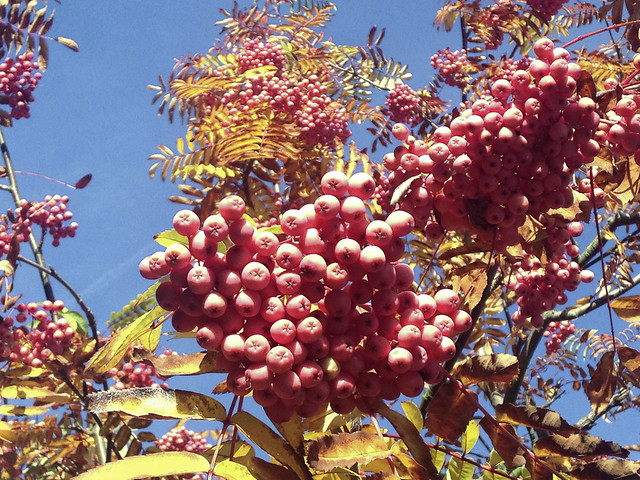
Splashes of colour are mostly seen in private gardens or from street planting - Hampstead Heath is still mostly green and gold although there are lots of berries. At home, there's coppery gold seen from my window as an ornamental cherry loses its leaves but, in the veg patch, the strawberry leaves and pineapple sage flowers win the day. (Which reminds me, I must have a look to see what else is still flowering.)
And while autumn slowly tightens its grip on nature, I'm whiling away the darker evenings with planning for next year and some crafting: painting a new seed box, twisting gathered creeper stems into quick wreaths and knitting an essential pair of fingerless gloves. And there's always reading; has anyone got any recommendations for a good page-turner? I'm currently reading 'An Orchard Odyssey' by Naomi Slade; part story, part reference, excellent read for any fruit grower and inspiration for wannabe fruitarians. I'll be reviewing it soon here.
There was frost on the rooftops this morning for the first time. I wonder if this is going to be a harder winter than last year? I can't remember seeing frost this early in November in London in recent years. I don't mind frost but it would nice if we didn't get the winter storms of last year. Let me leave you with a few warming moments on this chilly day.
And, finally, I'm in awe of this sumach tree (Rhus typhina) - could there be anything more beautiful? It reminds me of a woodblocked Indian print.
Posted by
Caro
at
09:28
26 Oct 2016
Five practical reasons why Muckster boots are the best (imho)
Disclosure - the boots in this review were gifted to me by the Muck Boot company for review. As ever, my reviews are an honest reflection of my opinions and experience of the product.
A good pair of wellies (rubber boots) can fulfil many functions - for dancing at a summer festival, running through the rain or, like Meghan Markle, stylish footwear for welly wanging in New Zealand! As a gardener, my needs are more practical. In all these cases, Muck Boots could fit the bill. Here's why.
Earlier this year I was sent a pair of wellies to try out. Naturally, as a gardener, this was a thrilling prospect as my old and very loved pair had been pushed into service one season too many and had cracked along the seam where my foot bends, allowing the elements access to my socks. Nothing worse than wet socks on a cold day, even if the ancient but beloved wellies had a cool Orly Kiely designer print.
I loved those old wellies so completely that I seriously considered trying to fix them with a tent repair kit (as you do) but somehow never got around to it. So they sat at the bottom of a cupboard for the past few years while I searched for a suitable replacement.
I was sent the ankle boots (the boots are also available with a taller leg) which are better for movement than my previous knee high rubber wellies; I'm tempted to buy a taller pair of Muck Boots for winter as the uppers are made of flexible neoprene and therefore fabulous for the walker's calves that I've been blessed with. As soon as I slipped them on I was won over. Oooh, so comfy. They have a shock absorbing inner sole, flex-foam insulation and breathable air mesh lining - which all adds up to all day comfort. This has been a boon time and again since I've been known to garden for eight hours without a break, especially up at the allotment, and my feet were just as fresh and perky at the end of the day as at the start.
Speaking of which, during their recent tour of New Zealand, the media noticed that Meghan Markle and her husband, Prince Harry, both wore Muck Boots. Need I say more?
December 2021: I originally wrote this review in October 2016 and, just to let y'all know, they're still in daily use! Over the past five years, I've regularly gardened and walked in them in all weathers, and still find them comfy, waterproof and, as already mentioned ~ahem~ stylish. (Maybe not so much that last one.) They're still going strong - no signs of wearing out any time soon.
I saw this tree the other day and thought it would make an excellent boot scraper; tiny problem, it's not near my home.
Luckily, I've since discovered a marvellous piece of kit for boot cleaning - simple and effective, I've been trying out the Mudbuster. It's basically a one-size fits all footwell with plastic spikes - fill with water, stick your boot in, do a little dance around on the spot and the mat does the work of cleaning for you - sides as well as soles. Brilliant. I wish I'd had this when my son was younger and played football every weekend; on the other hand, I think it could still be very useful for post-festival trainers (as well as gardening!). Not for me, I hasten to add, but for my festival going son - you can see from this photo that one size fits all!
My thanks to the Original Muck Boot Company who gave me a pair of RHS Endorsed Muckster II ankle boots to review. They are available from the company's website here.
My thanks also to Pennine Manufacturing who kindly sent me a Mudbuster to try out. Mudbusters can be ordered direct from Pennine via the phone number on the website or email sseddon@pennineindustries.com The unit retails at £10.99.
You Tube video of Mudbuster mats in action here.
A good pair of wellies (rubber boots) can fulfil many functions - for dancing at a summer festival, running through the rain or, like Meghan Markle, stylish footwear for welly wanging in New Zealand! As a gardener, my needs are more practical. In all these cases, Muck Boots could fit the bill. Here's why.
Earlier this year I was sent a pair of wellies to try out. Naturally, as a gardener, this was a thrilling prospect as my old and very loved pair had been pushed into service one season too many and had cracked along the seam where my foot bends, allowing the elements access to my socks. Nothing worse than wet socks on a cold day, even if the ancient but beloved wellies had a cool Orly Kiely designer print.
I loved those old wellies so completely that I seriously considered trying to fix them with a tent repair kit (as you do) but somehow never got around to it. So they sat at the bottom of a cupboard for the past few years while I searched for a suitable replacement.
Warm
Top of the agenda for a new pair, after the cost factor, was a neoprene lining. Why? Because, as with wetsuits, neoprene will keep your tootsies (and other extremities) warm and dry regardless of the weather. I'd discovered this as my old pair had a gorgeous orange neoprene lining. Mmmm, cozy, even in snow and ice.Comfortable
The new pair had to be comfy too, without one of those silly and impractical heels, with a non slip sole and fit for purpose. Enter the Muck Boot. I'd given serious thought to these a couple of years ago - yes, the search has been that long - but convinced myself these were for mucking out (makes sense, no?), i.e. the horsey brigade. But now several styles have been endorsed by the RHS which puts them firmly into gardening territory and very well they fit there too.I was sent the ankle boots (the boots are also available with a taller leg) which are better for movement than my previous knee high rubber wellies; I'm tempted to buy a taller pair of Muck Boots for winter as the uppers are made of flexible neoprene and therefore fabulous for the walker's calves that I've been blessed with. As soon as I slipped them on I was won over. Oooh, so comfy. They have a shock absorbing inner sole, flex-foam insulation and breathable air mesh lining - which all adds up to all day comfort. This has been a boon time and again since I've been known to garden for eight hours without a break, especially up at the allotment, and my feet were just as fresh and perky at the end of the day as at the start.
Lightweight
They're lightweight as well, something I'm grateful for when I've been on my feet for a while. In fact one day I forgot I was wearing them and went straight from the allotment to the supermarket. Hey, colour me stylish.Speaking of which, during their recent tour of New Zealand, the media noticed that Meghan Markle and her husband, Prince Harry, both wore Muck Boots. Need I say more?
Reliably waterproof
I put the boots through their paces on a long country walk up in the Chiltern Hills, accessed by a very muddy bridle path. In a dry summer this wouldn't have been a problem but it had been raining heavily the day before. In some places the only options were to slither up the bank or squelch through inches of wet mud. These are situations where the boots coped splendidly; yes, they were caked in sticky mud but my feet and, more importantly, socks were dry and I simply hosed the boots down at the end of the walk as they're entirely waterproof.Self cleaning and non slip soles
The boots are marketed as having a 'self cleaning and high traction outsole'. The high traction I can attest to but I found that the claim to self-clean worked only in part. After a day digging on my enriched but clay-based soil, I felt the need to pop the boots into a bag for storage as there were remaining bits of mud embedded in the sole, even after a short walk home. Okay, so that was on days when I didn't rinse them at the end of the day - who does? In the time honoured tradition, I took them off at the door and left them there.December 2021: I originally wrote this review in October 2016 and, just to let y'all know, they're still in daily use! Over the past five years, I've regularly gardened and walked in them in all weathers, and still find them comfy, waterproof and, as already mentioned ~ahem~ stylish. (Maybe not so much that last one.) They're still going strong - no signs of wearing out any time soon.
And that's when having a fantastic boot scraper comes in handy!
I saw this tree the other day and thought it would make an excellent boot scraper; tiny problem, it's not near my home.
Luckily, I've since discovered a marvellous piece of kit for boot cleaning - simple and effective, I've been trying out the Mudbuster. It's basically a one-size fits all footwell with plastic spikes - fill with water, stick your boot in, do a little dance around on the spot and the mat does the work of cleaning for you - sides as well as soles. Brilliant. I wish I'd had this when my son was younger and played football every weekend; on the other hand, I think it could still be very useful for post-festival trainers (as well as gardening!). Not for me, I hasten to add, but for my festival going son - you can see from this photo that one size fits all!
My thanks to the Original Muck Boot Company who gave me a pair of RHS Endorsed Muckster II ankle boots to review. They are available from the company's website here.
My thanks also to Pennine Manufacturing who kindly sent me a Mudbuster to try out. Mudbusters can be ordered direct from Pennine via the phone number on the website or email sseddon@pennineindustries.com The unit retails at £10.99.
You Tube video of Mudbuster mats in action here.
Labels:
Essential tools,
garden wellies
Posted by
Caro
at
17:00
9 Oct 2016
#UpandAutumn
... to borrow a hashtag phrase which I keep seeing on Twitter. I love it, it's so appropriate, especially given the sunny weather we've had this week to start the season off. There's nothing quite like blue skies to make me feel motivated and now is not the time to start slacking off in the garden. (I've done enough of that already this summer!)
There's bulbs to plant. I have a large basket full waiting to be planted; alliums, daffodils, snowdrops and crocuses can go in now so that they have a chance to develop roots while the soil is still warm - that's particularly true of alliums - and I also have about 250 tulip bulbs which I'll plant next month when it's a bit colder. That's nowhere near the thousands of bulbs that are planted in public gardens but I know my limitations - kneeling pads, restorative yoga and Deep Heat at the ready.
Every year I add to the previous year's tulips; I never lift the bulbs when they've finished flowering but nip off the flowering stalk and wait for the leaves to die back. Most of the bulbs have proved reliably perennial so far - fingers crossed for this year as well, although realistically they'll be less vigorous year on year. Bargains are a necessity as my work in the communal gardens here is not funded. This year, I'm very taken with 'Sherbet' bulbs from Morrison's supermarket. I grew them last year and there were some absolute beauties in the mix. I paid £2 per bag of 12 which I think is quite good, even with no budget to speak of.
Another job waiting for my attention is the planting of several grasses in the middle garden. Remember that space? Yep, big plans, not enough time. It's mostly been used as a holding/nursery area for plants this year while I flesh out a plan and watch how the light falls across the garden throughout the year. As luck would have it, I collected a car load of plants from the T2 tea collaboration with Rich Landscapes last week and autumn is a good time to plant perennials. I'm hoping to dedicate a large part of my weekend to weeding, planting and pruning; it's much needed.
The veg patch is ticking over at the moment. Braeburn apples have ripened and are, amazingly (touch wood), still on the tree. I usually pick one a day to munch on. A few pears need to be picked and ripened indoors and, huge excitement, I've got five quinces ripening! This is a first and I'm really looking forward to cooking with those - or even just being able to smell the famous perfumed quince at last.
Borlotti beans have coloured up beautifully and are now an astonishingly vibrant red. I don't know yet what they taste like as I'm saving any ripened pods until I have enough to cook with. Likewise with the tomatoes. Remember my despair a few weeks back? I needn't have panicked, I now have bowls of beautiful yellow plum shaped tomatoes - and no sign of blight. I'm still going to choose my tomato seeds with better care next year though. It's worth noting that Banana Legs (the yellow plum tomatoes) were prolific, each fruit 2 to 3 inches long and each plant growing several clusters of 5 to 6 fruits. I bought the seeds from Pennard Plants at one of the early RHS shows.
I've still got to plant out Cavolo and curly kale but it's a question of where? The patch is still stuffed with chard, beetroot (small leaves of both excellent in salads), broccoli, rhubarb and radishes that I'm letting flower so I can try the pods - supposedly a restaurant delicacy, don't you know!
And then there's seed saving ... and sowing for next year's annuals ... and mulching ... and, and, and. Onwards, always onwards.
There's bulbs to plant. I have a large basket full waiting to be planted; alliums, daffodils, snowdrops and crocuses can go in now so that they have a chance to develop roots while the soil is still warm - that's particularly true of alliums - and I also have about 250 tulip bulbs which I'll plant next month when it's a bit colder. That's nowhere near the thousands of bulbs that are planted in public gardens but I know my limitations - kneeling pads, restorative yoga and Deep Heat at the ready.
Every year I add to the previous year's tulips; I never lift the bulbs when they've finished flowering but nip off the flowering stalk and wait for the leaves to die back. Most of the bulbs have proved reliably perennial so far - fingers crossed for this year as well, although realistically they'll be less vigorous year on year. Bargains are a necessity as my work in the communal gardens here is not funded. This year, I'm very taken with 'Sherbet' bulbs from Morrison's supermarket. I grew them last year and there were some absolute beauties in the mix. I paid £2 per bag of 12 which I think is quite good, even with no budget to speak of.
Another job waiting for my attention is the planting of several grasses in the middle garden. Remember that space? Yep, big plans, not enough time. It's mostly been used as a holding/nursery area for plants this year while I flesh out a plan and watch how the light falls across the garden throughout the year. As luck would have it, I collected a car load of plants from the T2 tea collaboration with Rich Landscapes last week and autumn is a good time to plant perennials. I'm hoping to dedicate a large part of my weekend to weeding, planting and pruning; it's much needed.
The veg patch is ticking over at the moment. Braeburn apples have ripened and are, amazingly (touch wood), still on the tree. I usually pick one a day to munch on. A few pears need to be picked and ripened indoors and, huge excitement, I've got five quinces ripening! This is a first and I'm really looking forward to cooking with those - or even just being able to smell the famous perfumed quince at last.
Borlotti beans have coloured up beautifully and are now an astonishingly vibrant red. I don't know yet what they taste like as I'm saving any ripened pods until I have enough to cook with. Likewise with the tomatoes. Remember my despair a few weeks back? I needn't have panicked, I now have bowls of beautiful yellow plum shaped tomatoes - and no sign of blight. I'm still going to choose my tomato seeds with better care next year though. It's worth noting that Banana Legs (the yellow plum tomatoes) were prolific, each fruit 2 to 3 inches long and each plant growing several clusters of 5 to 6 fruits. I bought the seeds from Pennard Plants at one of the early RHS shows.
I've still got to plant out Cavolo and curly kale but it's a question of where? The patch is still stuffed with chard, beetroot (small leaves of both excellent in salads), broccoli, rhubarb and radishes that I'm letting flower so I can try the pods - supposedly a restaurant delicacy, don't you know!
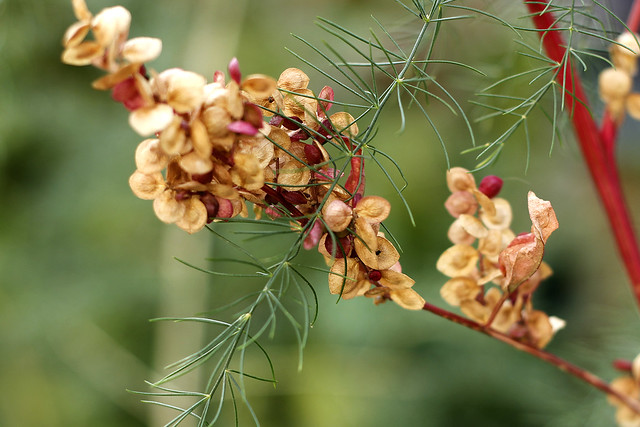 |
| ~Orache (Atriplex rubra) aka Mountain Spinach and Fennel - both self seed enthusiastically at this time. ~ |
And then there's seed saving ... and sowing for next year's annuals ... and mulching ... and, and, and. Onwards, always onwards.
Like I say, up and at 'em.
1 Oct 2016
Sweet peas all summer
I often forget to sow sweet peas, either completely or until it's rather too late but, last winter, I remembered. In an exercise to rid my seedbox of outdated seeds, I came across a random selection of sweet pea seeds. A few were odd seeds at the bottom of the packet, others were facing or past their best before date (not that that seems to matter much). With all these leftovers, I reckoned that I'd nothing to lose with a December sowing; after all, it wouldn't matter if they didn't germinate or grow as there would be time in the spring to sow again with fresh seed.
Contrary to my expectations, they did grow and I picked my first bunch for an Instagram photo on 5th June. All through June, July and August I enjoyed the heady evening scent of prolific sweet peas in the garden. I couldn't believe that they would flower for 3 months from one sowing and I became determined that they'd still be flowering at the end of August. That involved a lot of deadheading, let me tell you!
 | |
|
By the first week in September I was ready to let them finish their botanical journey and make seedpods so I stopped deadheading. By mid-September I found a dried seed pod among the still blooming stems ... and today, the last day of September, I picked the last tiny bunch of flowers. Four months of flowers! Incredible. (At least that's the way it seems to me. Is this lengthy flowering usual?) I'd like to claim that it was my prowess as a gardener that achieved this (hohoho) but, realistically, I like to think anyone could do the same. There are a few key points however and this is what I did:
1. Start your seedlings early. Sweet peas for next year can be sown at any time now and left in a sheltered place, eg, cold frame, greenhouse or cloche. Depending on your location and the weather, they may need additional protection if the winter is harsh and you're growing north of, say, Milton Keynes. (Mine survived last year's relatively mild winter on my balcony with no added protection. This year I think I'll put them in my friend's greenhouse.)
2. Sow into deep pots. I put 3 or 4 seeds into each 10cm diameter deep pot (deep root trainers are also ideal) and placed the pots on a shelf on my tiny sheltered balcony. Amazingly, I had 80 - 100% germination in each pot and, bar a tiny amount of watering, largely left the seedlings to get on with it.
3. Keep an eye on the plants. By February I needed to pinch out the tops to stop them getting leggy. My balcony is part shaded on three sides so the plants had a tendency to grow towards the light. Pinching out the tops above the first four sets of true leaves also helps the plants to bush out.
4. Plant out from mid-April (if possible). I had other distractions so mine went outside in early May. I planted the seedlings without separating them to minimise root disturbance. At four to a pot that's not ideal but they had plenty of room to grow once planted; each cluster of seedlings was about 40cm from its neighbour. I added a small amount of blood, fish and bone to the planting holes, mixed this in with the soil and bunged the whole potful of seedlings into the prepared hole. Each plant was tied in to the prepared trellis and the row watered well.
5. Water, water, water. I made sure to prioritise watering the sweet peas so that the soil stayed moist. I also gave them a very occasional boost with some diluted home-made comfrey feed. And I tried to aim for the roots to keep the leaves dry. (The wet spring/summer helped as well, I'm sure.)
6. Support and encourage. I tied them in as they grew (actually, it was my neighbour who helps who did that) and we both kept on top of regular deadheading and watering. As soon as the each bloom started to fade, it were cut back to the base of its stem to encourage more flowers.
7. Label and save. As these plants did so well, I'm keen to save the seed for next year. The plants tended to twine around and through each other as they grew up the trellis. Stupidly, I didn't label the stems so, now that I'm saving the seed pods, I have no idea which sweet pea I'll get when I sow those seeds - it will be a nice surprise!
I had some beautiful variations in the flowers as the summer wore on and suspect this might be due to cross pollination. Has anyone else found this? In a one and a half metre row, I was growing purple/black, white, lavender, pale pink plus shades of bright pink and shades of purple (Chiltern Seeds 'Summer Sizzler' and 'Flamenco Mix', my favourites and sent to me by the very kind Flighty). I'm hoping that those variations will appear in next year's flowers because the challenge now is to sow the seeds that I've saved and see if I can create a repeat performance.
Update: I forgot to mention that all but the very dark flowers had ridiculously long stems as well - so long that I got the tape measure out more than once - and the longest was 16" !!
How did everyone else do with their sweet peas this year? Did my plants do well or was this a universal trend? And who's started next year's annuals off already? (I have to do mine this weekend!)
 |
| ~ a few photos taken in August ~ |
Labels:
Sweet Peas
Posted by
Caro
at
09:47
28 Sept 2016
Wildlife Wednesday: picturing Palomena
Common Green Shield Bugs (Palomena prasina) are regular garden inhabitants in the southern part of the UK but are very very good at hiding thanks to their brilliant camouflage colours. On seeing this one - because it crawled on my hand as I squeezed the scented leaves of a huge 'Attar of Roses' pelargonium planted outside - I immediately thought, "Where's Wally?" Remember those books? I could never find Wally with his red and white striped hat and jumper among all the hundreds of other people in the cartoon. I carefully manoeuvred this little guy off my hand and back onto the plant - although they're sap sucking insects, they don't do any significant damage in the garden so it's okay to let them be.
Their relatives, the Southern Green Shield Bug, on the other hand, will be found on runner and french beans and, as I found out the summer before last, on tomatoes. I had the immature bugs across my entire crop in the warm summer of 2014. They didn't appear to do much damage, just the occasional nibble into my fruits.
Apparently both types of Shield Bugs (known as stink bugs in the US) are gradually moving northwards to colonise gardens in the Midlands and beyond as our weather becomes more temperate. They're regular visitors to my veg patch - do you see them where you live?
Labels:
bugs,
Green Shield Bug,
organic gardening
Posted by
Caro
at
23:31
22 Sept 2016
Rich Tea
My life as a blogger occasionally takes me to some curious places.
One evening last week, for example, I found myself sipping tea in the company of Harry and David Rich. Who they, do I hear you ask? Only the brothers who won gold at Chelsea last year with their garden - and shack on tracks - for Cloudy Bay!
The personable duo's landscaping business was already keeping them busy but winning at the Chelsea Flower Show two years on the trot augmented their rise to fame and, in the past couple of years, the brothers have been quietly raising their game. As well as business projects, there was a garden installation for Saatchi's Chanel exhibition, a regular television slot on ITV's This Morning, filming with Charlie Dimmock (remember her?) to make Garden Rescue (there's just time to catch it on BBC iplayer) and now ... a collaboration with Australian tea company T2.
It was the tea connection that got me involved. I received an email inviting me to an 'urban gardening event' in Chelsea's Kings Road. Intrigued, I asked for more details and learned that T2 were launching a limited edition range of veg patch teas with an in-store autumn garden created for the event by the Rich Brothers. Now we've all come to terms with fruit teas, herb teas and iced tea but vegetable tea? Visions of cabbage water were conjured up in my mind. I felt I should investigate - and I was very curious to see this autumn garden created by two luminaries of the gardening world.
I was pretty sure that the new Veg Patch teas would be delicious - what would be the point otherwise? - and I was right. If you drink juiced fruit and vegetables every day (which I do), the flavours look very appealing. Of the four flavours Carrot Ginger & Turmeric was my first choice with Apple Kale & Ginger a close second. There are two more flavours: Green Tea + Spinach and Rooibos Beetroot & Broccoli. In the last two flavours, the green tea and rooibos were the dominant flavours but tweaked into deliciousness by the addition of red pepper, lemongrass, coriander and lemon verbena.
I love the concept of using herbs and vegetables to make tea. I guess most of us have dabbled with freshly picked herbs of peppermint, lemon verbena, ginger and perhaps thyme (good for sore throats) but I would never have thought of adding dried vegetables. It makes a lot of sense when considering the health benefits of the ingredients used - turmeric is a great anti-inflammatory, kale and spinach are great for boosting energy, broccoli is a cruciferous vegetable with great anti-carcinogenic properties. So not only are the teas extremely pleasant to drink (and can be served hot, chilled or mixed into cocktails), they're also good for you. I'm sold - and we gardeners are fond of a cup of tea, are we not?
But did the 'urban garden event' deliver? I feel very disloyal for saying no, not quite. But read on ... because that's just me. The plants didn't quite add up to my expectation of an autumn garden because, given that the new product was veggie teas, I anticipated raised beds filled with fennel, carrots, beetroot, kale and herbs. Just the sort of thing that Jekka McVicar does so well for her stall at Chelsea Flower Show. (She has her own tea collaboration - I forget with who.)
Perhaps my expectations were too literal. The planting was undoubtedly gorgeous, consisting of several groups of plants in large pots and planters. It was autumn inspired with several myrtle shrubs for their delicious scent, Pennisetum grasses for that gorgeous autumnal golden/pink glow and various Sanguisorbas to bring a berried burgundy to the display. I gleaned all this from chatting to the two Rich brothers who, incidentally, are charming, funny, entertaining, chatty and very polite. It's heartening to see that success doesn't seem to have gone to their heads. I worked lots of questions into the conversation but the main one had to be, "Builder's tea or Veg Patch tea - which would you choose?" And their answer, genuinely, was that they really like T2 teas, especially the Veg Patch ones. And on that, we agreed.
Veg Patch teas are a limited edition range and can be bought from T2tea.com at a cost of £16 per box. Londoners can see the garden installation at the Chelsea store in the Kings Road until early October.
One evening last week, for example, I found myself sipping tea in the company of Harry and David Rich. Who they, do I hear you ask? Only the brothers who won gold at Chelsea last year with their garden - and shack on tracks - for Cloudy Bay!
 |
| Rich Brothers talking about their Chelsea Garden 'Vital Earth, Night Sky' 2014 (Click on link to watch short video) |
The personable duo's landscaping business was already keeping them busy but winning at the Chelsea Flower Show two years on the trot augmented their rise to fame and, in the past couple of years, the brothers have been quietly raising their game. As well as business projects, there was a garden installation for Saatchi's Chanel exhibition, a regular television slot on ITV's This Morning, filming with Charlie Dimmock (remember her?) to make Garden Rescue (there's just time to catch it on BBC iplayer) and now ... a collaboration with Australian tea company T2.
It was the tea connection that got me involved. I received an email inviting me to an 'urban gardening event' in Chelsea's Kings Road. Intrigued, I asked for more details and learned that T2 were launching a limited edition range of veg patch teas with an in-store autumn garden created for the event by the Rich Brothers. Now we've all come to terms with fruit teas, herb teas and iced tea but vegetable tea? Visions of cabbage water were conjured up in my mind. I felt I should investigate - and I was very curious to see this autumn garden created by two luminaries of the gardening world.
I was pretty sure that the new Veg Patch teas would be delicious - what would be the point otherwise? - and I was right. If you drink juiced fruit and vegetables every day (which I do), the flavours look very appealing. Of the four flavours Carrot Ginger & Turmeric was my first choice with Apple Kale & Ginger a close second. There are two more flavours: Green Tea + Spinach and Rooibos Beetroot & Broccoli. In the last two flavours, the green tea and rooibos were the dominant flavours but tweaked into deliciousness by the addition of red pepper, lemongrass, coriander and lemon verbena.
I love the concept of using herbs and vegetables to make tea. I guess most of us have dabbled with freshly picked herbs of peppermint, lemon verbena, ginger and perhaps thyme (good for sore throats) but I would never have thought of adding dried vegetables. It makes a lot of sense when considering the health benefits of the ingredients used - turmeric is a great anti-inflammatory, kale and spinach are great for boosting energy, broccoli is a cruciferous vegetable with great anti-carcinogenic properties. So not only are the teas extremely pleasant to drink (and can be served hot, chilled or mixed into cocktails), they're also good for you. I'm sold - and we gardeners are fond of a cup of tea, are we not?
But did the 'urban garden event' deliver? I feel very disloyal for saying no, not quite. But read on ... because that's just me. The plants didn't quite add up to my expectation of an autumn garden because, given that the new product was veggie teas, I anticipated raised beds filled with fennel, carrots, beetroot, kale and herbs. Just the sort of thing that Jekka McVicar does so well for her stall at Chelsea Flower Show. (She has her own tea collaboration - I forget with who.)
Perhaps my expectations were too literal. The planting was undoubtedly gorgeous, consisting of several groups of plants in large pots and planters. It was autumn inspired with several myrtle shrubs for their delicious scent, Pennisetum grasses for that gorgeous autumnal golden/pink glow and various Sanguisorbas to bring a berried burgundy to the display. I gleaned all this from chatting to the two Rich brothers who, incidentally, are charming, funny, entertaining, chatty and very polite. It's heartening to see that success doesn't seem to have gone to their heads. I worked lots of questions into the conversation but the main one had to be, "Builder's tea or Veg Patch tea - which would you choose?" And their answer, genuinely, was that they really like T2 teas, especially the Veg Patch ones. And on that, we agreed.
Veg Patch teas are a limited edition range and can be bought from T2tea.com at a cost of £16 per box. Londoners can see the garden installation at the Chelsea store in the Kings Road until early October.
Labels:
garden event,
Rich Brothers,
T2tea,
tea,
vegpatch tea
Posted by
Caro
at
13:23
15 Sept 2016
Plot pickings
As the summer slowly transitions into autumn, is it all doom and gloom? No, not at all. In fact it's almost a relief that I no longer have to think about where to squeeze in a few more plants and can start to think about preparing for the winter garden and planning for next year. I may have felt slightly deflated at the lack of blooms in my last post but that just shows how wrong I was to focus purely on the floriferous feel of the garden.
High spirits were swiftly restored within a few days by the evening plot pickings. As with most other veg gardeners, I'm currently able to collect beans, beetroot, chard, radishes, raspberries and Cape gooseberries (delicious but few!) most evenings. As this is small space gardening, I don't get trug loads of produce but tiny tastes are definitely better than none.
We've not done too badly this summer; there's usually enough for me and my occasional helper to have a bowlful of beans and raspberries every week at the moment - and plenty of beans and plot courgettes to hand round to a few neighbours. I like to share when I can, there would be no joy in keeping it all in the freezer for myself.
The courgettes that I planted out rather later than recommended are putting out small fruits; I don't mind as I've already had a courgette/marrow overload from my plot neighbour up at the allotments. And I read of a good tip recently - if you cut off the first tiny fruits, the plant is encouraged to pump out lots more larger sized fruit. I've done as suggested so we'll see ... and the tiny courgettes have been sliced and added to a creamy bacon and courgette tagliatelle. (Waitrose recipe here, if you're interested.)
The beetroot has been really successful this year (Baby Bona from Chiltern Seeds). I've been picking plump round beets with a sweet taste - perfect for my morning juice. (Yes! Beetroot in a juice! It's really delicious in a juice with apples, carrot, lemon, broccoli stem, cucumber and yellow pepper. Yummy and energising!)
So far I've restricted myself to picking only the 'french' beans that I'm growing and saving the Borlotti beans to plump up. I'm growing 'Cobra' climbing beans which are aptly named; they're normally pencil straight but, where I've missed a few, they've grown fat and curled round on themselves - more boa constrictor than cobra but the similarity is amusing.
The Borlottis, on the other hand, are perplexing me. I've seen so many pictures of brightly coloured pink and cream pods - surely one of the reasons to grow them! Mine, however, are pale green pods that occasionally mature to sport some magenta streaks. Is this usual? It's definitely not what I was expecting. Will they eventually turn pink? Is there a reason that some pods are streaked and others not? If you know, do tell.
Of course I may not get any mature Borlottis at all if the munching molluscs keep at it. Leaves and pods at the top of the plants have been decimated - the slime trails tell their own story. I mean, really, six feet off the ground - the very cheek of it!
So all I can say is .... thank goodness for broccoli. (Maybe I should get some fleece over that.)
High spirits were swiftly restored within a few days by the evening plot pickings. As with most other veg gardeners, I'm currently able to collect beans, beetroot, chard, radishes, raspberries and Cape gooseberries (delicious but few!) most evenings. As this is small space gardening, I don't get trug loads of produce but tiny tastes are definitely better than none.
We've not done too badly this summer; there's usually enough for me and my occasional helper to have a bowlful of beans and raspberries every week at the moment - and plenty of beans and plot courgettes to hand round to a few neighbours. I like to share when I can, there would be no joy in keeping it all in the freezer for myself.
The courgettes that I planted out rather later than recommended are putting out small fruits; I don't mind as I've already had a courgette/marrow overload from my plot neighbour up at the allotments. And I read of a good tip recently - if you cut off the first tiny fruits, the plant is encouraged to pump out lots more larger sized fruit. I've done as suggested so we'll see ... and the tiny courgettes have been sliced and added to a creamy bacon and courgette tagliatelle. (Waitrose recipe here, if you're interested.)
The beetroot has been really successful this year (Baby Bona from Chiltern Seeds). I've been picking plump round beets with a sweet taste - perfect for my morning juice. (Yes! Beetroot in a juice! It's really delicious in a juice with apples, carrot, lemon, broccoli stem, cucumber and yellow pepper. Yummy and energising!)
So far I've restricted myself to picking only the 'french' beans that I'm growing and saving the Borlotti beans to plump up. I'm growing 'Cobra' climbing beans which are aptly named; they're normally pencil straight but, where I've missed a few, they've grown fat and curled round on themselves - more boa constrictor than cobra but the similarity is amusing.
The Borlottis, on the other hand, are perplexing me. I've seen so many pictures of brightly coloured pink and cream pods - surely one of the reasons to grow them! Mine, however, are pale green pods that occasionally mature to sport some magenta streaks. Is this usual? It's definitely not what I was expecting. Will they eventually turn pink? Is there a reason that some pods are streaked and others not? If you know, do tell.
Of course I may not get any mature Borlottis at all if the munching molluscs keep at it. Leaves and pods at the top of the plants have been decimated - the slime trails tell their own story. I mean, really, six feet off the ground - the very cheek of it!
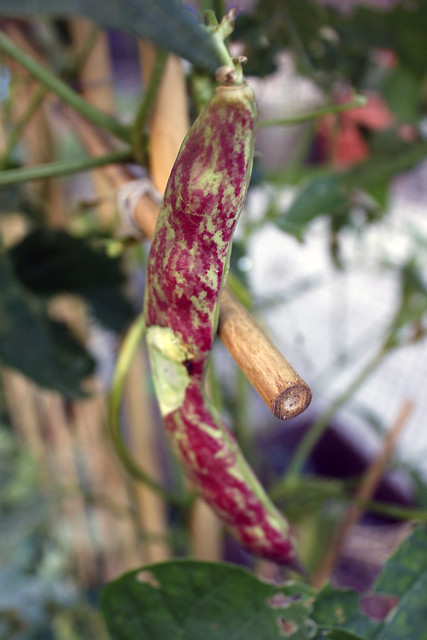 |
| This is one of the tinier munchings - there are pods that are positively naked on the other side. Grrr. |
So all I can say is .... thank goodness for broccoli. (Maybe I should get some fleece over that.)
Labels:
Autumn,
Borlotti beans,
Chiltern Seeds,
grow your own,
Harvest
Posted by
Caro
at
09:30
14 Sept 2016
Wildlife Wednesday: searching for late summer nectar
There aren't so many bees in the garden now - compared to the height of summer. But a steady drone on a warm still evening is very heartening to hear. The lavender bushes have only a few fresh flowers now but the bees are still finding what's left, as well scabious, comfrey and herb flowers. The top favourite at the moment seems to be verbena - I have both V. bonariensis and V. hastata growing among the veg here. The taller V. bonariensis is a bit of a nuisance as it's getting slightly floppy but well worth it for the pollinators it's attracting to the garden.
Yesterday evening here in London, the warm and still evening air could almost make me believe I was holidaying in the Mediterranean somewhere.
I hope the weather is being kind to you wherever you may be gardening this week!
Labels:
Bees,
biodiversity,
Pollinators
Posted by
Caro
at
10:38
4 Sept 2016
Move along please; the show's over
As the garden transitions from summer into autumn, a plan to keep the garden looking lovely for a bit longer has been much on my mind. And never more so than the week before last as my entry for Camden in Bloom was shortlisted and judgement day was on the Friday.
It was a singularly underwhelming event. The big clue is in the title: "In Bloom". The veg patch garden, at this stage, was not - unless you count a struggling scabious, some scraggy calendula and a few end-of-line sweet peas. After an exhausting week of tidying, deadheading, weeding and planting in the twilight hours between work and nightfall, Friday's dawn revealed grey skies and, as if scripted, heavy rain poured down only and exactly for the twenty minutes that the judges looked around.
There were two of them (one admin, one Mayor), the third wasn't able to attend; pity - he was the gardener, Kew trained, and the only one who might have understood the hard work that went into creating a garden way past its mid-summer heyday. On the plus side, the mayor appreciated the smell of herbs such as Blackcurrant sage and lavender, lingering awhile to release the scent. He'd obviously been told that plants that attracted bees were good plants; once I realised this and the sparse horticultural experience the pair brought to the event, I thought it wise to limit myself to pointing out any bee friendly plants without naming them. I'm not holding my breath for a winner's medal. The verdict will be announced in late September.
So, moving on, I'm now thinking about how to extend colour in the garden next year. The perennial patch was originally created as an area for cut flowers before I realised how many perennials or self-seeders I had to rehouse. Back in the spring, the space quickly filled with transplanted foxgloves, verbenas, Centaurea, scabious, alliums, achillea, astrantias, poppies, feverfew and ox-eye daisies; to these I added freesia bulbs, cerinthe seedlings, honesty, red clover, Geums and Dianthus barbutus (the tall pinks). On the other side of the path, self seeded nasturtiums put out triffid-like branches that entwined themselves up, around and through sweet peas, calendula, strawberries, verbena, orache. It was a glorious sight ... in June and July.
Admittedly the short sharp bursts of extreme heat experienced in recent weeks haven't helped a garden without easy access to water. Astrantias and the shorter hybrid Achilleas succumbed to parched conditions and now resemble dried flowers, the cerinthe also crisped up and set seed, as did the calendulas. Even nasturtiums that usually politely wait until late summer to start taking over the garden have exhausted themselves and been swamped by black aphids (and now removed).
But ... Always look on the bright side of life says Monty Python star Eric Idle. I paused, thought and concluded that, yes, this is the perfect time to review and rethink. There were elements of this border that I really disliked, too much green of a similar hue, not enough textural interest. The reality didn't live up to the dream. The challenge now is to change the garden so there's something to look forward to throughout the seasons - isn't that what we all strive for? It won't be easy in this small space (the entire veg patch island is only 10 x 3 metres (about 33 x 10 feet) with the perennial border just one quarter of that. Thinking cap on.
So, how's your garden this autumn?
Any regrets, mistakes or ideas for change next year?
I'm thinking more Stipa grasses and echinacea here - and I'd love a bank of Heleniums if only the slugs didn't get there first, every. damn. time.
Labels:
Autumn,
Camden in Bloom,
succession planting
Posted by
Caro
at
17:29
31 Aug 2016
Wildlife Wednesday: Standing room only
What is that tiny creature?
Is that a Minpin in my garden scaling the heights of a salvia branch?
Is that a Minpin in my garden scaling the heights of a salvia branch?
Let's take a closer look.
Umm... I'm not sure that helps - the image could benefit from being a tad sharper. I like to think that this looks like a tiny winged Ewok standing perched on the ledge of the salvia flower. Look how his little feet and hands are firmly planted while he feasts.
I'm fascinated by the tiny kingdom of bugs that visit the garden. Salvia flowers are tiny but deep; I've watched bees grab the flower at the base and drill through the sides to get at the nectar inside. This hoverfly could obviously get what he wanted from an easier route in.
The operation was seamless: a horizontal approach to the target, home in, landing gear down, munch. Perfect. This was one of those moments that I always feel very privileged to witness. Nature is awesome.
Happy Wednesday!
You probably know this already:
Minpins are tiny people who live at the top of trees in the Forest of Sin, as told in Roald Dahl's last book 'The Minpins'
Ewoks are the forest creatures that help defeat the Galactic Empire in the Star Wars movies.
Labels:
bugs,
hoverflies,
wildlife
Posted by
Caro
at
19:22
27 Aug 2016
One tomato, two tomat... oh.
 |
| Heritage tomato 'Vintage Wine' - yet to mature |
Yes indeed, here we are again as summer fades and I have yet to reap a decent harvest of tomatoes for the second year running. As I roll my eyes heavenwards and raise my eyebrows, I have to ask "Why?" - as in, why is this happening?, why am I bothering? and just why! oh why! My frustration is extreme.
Last year's plants produced heaps of fruit but blight struck before any of it could ripen. This year I bought fresh seed with thrilling names like 'Banana Legs', 'Vintage Wine' and 'Deep Orange Strawberry', carefully chosen to produce a tempting cornucopia of tomatoes of different hues, sizes and textures for summer cooking and eating. Oh boy, was I looking forward to this!
Sowing, germination, potting on - all went as planned. The seedlings grew at first on my windowsills then outside on my balcony where light breezes ruffled their leaves and strengthened the stems. I moved the sturdiest into large pots of peat free multi purpose when the weather warmed (I wanted to be able to move the pots around if needed) and left these outside where they would get water and some sun. I rashly judged that I had too many tomato plants and gave some away.
And then the rains came.
Slugs languished in a sensuously drunken fashion at the very pinnacle of the plants, or nestled into the leaves further down. The sight of this abandoned mollusc behaviour became the norm, even in daylight hours. I persevered and picked them off, time after time.
Despite the relentless slug sorties, the plants grew and thrived. But, on some, flowers just didn't form. I boosted the plants with the gardener's friend, Tomorite. A few tiny fruits formed but it was too little, too late. I've had two ripe tomatoes from plants given to me by my sister and I live in hope for the few home-grown tomatoes still to ripen: one beefsteak Vintage Wine lately formed and what will amount to a small bowl of Banana Legs.
 |
| Banana Legs - these should be as yellow as a .... yep, banana. |
Naturally, further research was needed; I've been reading for weeks about other bloggers generous gatherings of luscious tomatoes - or perhaps that was my envious imagination. Anyhow, the RHS advises that tomatoes, although relatively easy to grow, are prone to physiological disorders ie problems encountered in controlling the plants sensitivity to temperature, nutrients and light. So... not easy at all then. Apparently even greenhouse grown fruit are susceptible to problems. I recall a BBC programme where Alys Fowler built a tiny greenhouse out of reclaimed windows for her tomato plants in a bid to keep blight at bay. Did it work? No. Even experienced growers suffer. And yet, a few years ago, I had plenty of tomatoes from plants literally plonked into the soil on my balcony - they were still chucking out fruit in December!
So what's the answer? Anna Pavord in her book 'Growing Food' writes that many cultivars, particularly cordons, are best grown under glass although can be grown outside if circumstances are right. All my choices this year are a Heritage cordon variety and, without a greenhouse, would have been best grown against a sunny wall for warmth and shelter. The book also advises that tomatoes grown outside do best in soil that has been well-manured and in a different spot to previous year's growth to avoid build up of soil diseases. Pot grown tomatoes are best fed and watered twice a day in a hot summer. Another fail on my part - I was sometimes too busy elsewhere to check.
I gleaned another clue from Joy Larkcom's book 'Grow your own vegetables': she says most heritage or heirloom tomatoes are late maturing. (There's hope yet.) Cordon types need to have the tops pinched off (stopped) in late summer to let any fruit mature and ripen.
So to summarise, these are lessons to take forward to next year:
- Choose seeds wisely. Very important to find out whether seeds are suitable for outdoor growing.
- Choose early maturing cultivars to beat blight and poor summer weather.
- If growing outdoors, dig a 12" deep trench and line with comfrey leaves or dig in well rotted manure a couple of weeks before planting out. Tomatoes like a moist free draining soil.
- Find a nice heat retaining wall to grow against. (I'm wondering if a black backcloth might also work?). Hedges are not suitable places to plant as the soil will be too dry.
- If I must grow beefsteak tomatoes (and I feel I might), treat them like chillies with plenty of warmth and light.
- Try not to plant tomatoes in the same spot; they need a different plot every four years to minimise build up of soil problems.
It certainly isn't the piece of cake we're led to believe - Joy Larkcom devotes eight pages of her very comprehensive book to the subject of growing tomatoes.
I feel heartened having written this post as there may just be enough time for my tomatoes to ripen - with the right wall to lean on. Next year, I'll plant early and try them up at the allotments (although I heard there's blight up there this year). And maybe I'll curb my tendency to opt for beautifully named Heritage varieties, a bit like choosing which horse to back in the Grand National, although 'Outdoor Girl' and 'First in Field' have done well for me in the past.
It would be really good to hear which varieties have done well for other growers this summer with recommendations for a good eating and good cooking tomato. I'm tempted by 'Ferline' - has anyone grown it?
Labels:
how to grow,
problems,
RHS advice,
Tomatoes
Posted by
Caro
at
11:30
15 Aug 2016
Best seen from above (my chillies, I mean)
I'm such an noodlehead when it comes to gardening thoughts, being easily diverted from my path by the moment - a chance sighting of a spectacular plant or a conversation peppered with useful tips will send me veering off at a tangent.
As a result of this tendency to wiffle about, I tend to post about something and subsequently fail to return to the subject. I was reminded of this as I heaved one of my chilli plants back onto the bench from the floor - it's put there when my son wants to create a space to sit in my plant stuffed balcony.
When I look out onto my tiny balcony, I see how beautifully the chilli plants are growing. I last wrote about these chillies as tiny newly bought plants so it's time for an update.
Viewed from above, Tangerine Dream is a handsome beast of a plant. I am (usually) pants at growing chillies so, flushed with success, I'm sharing this update to show that anyone can have a go and achieve a beautiful plant, whether the fruit gets eaten or simply admired.
I'll confess that I have no idea how best to use these particular chillies (suggestions invited!) but they are undeniably fun and frivolous as chillies go. I'm accustomed to the more generic red supermarket chillies for my cooking but was intrigued by the names and trying something a little unusual.
Tangerine Dream is a relatively mild vegetable chilli while Fairy Lights, being a spice chilli, is considerably hotter, although nowhere near the heat of superhot chillies. When will they be ready to pick? I have no idea! I'm not sure that I want that day to come as these plants are a joy to behold at the moment. Fairy Lights is currently gearing up to transform its fruit from purple through yellow into red - the colours during this change are sublime.
The chilli that I grew myself from seed this year is Thai Green Curry (also from Sea Spring Seeds); It's another mild vegetable chilli but has long slim pods. I sowed the seeds just after I bought the other two plants so Thai Green is less developed than those. At the moment there's only one chilli pod but lots of flowers so I'm hoping for more. This is not such a pretty plant but may well be more useful. It will be good to have a choice for once - surely the whole point of growing your own!
Growing notes: (What worked for me)
Buy small or sow early indoors (mid-February)
Pot on into 10 litre pot when plant is about 3 inches tall. Be careful not to handle the stem.
Use good multi purpose compost; mix in added fertilizer, eg chicken manure pellets
Water when top 2 inches of soil in the pot feels dry.
Give a boost by watering in additional plant food, eg, liquid seaweed.
Grow in a mild sheltered environment - next to a sunny house wall is ideal.
Both of the purchased chillies have been very sturdy healthy plants that have grown steadily. I followed the advice given by Sea Spring Seeds at purchase and repotted the plants into their final 12 litre pots using good compost (Dalefoot peat free) with added chicken manure pellets. They've been fed when I remember (but not more frequently than weekly) using either Tomorite, liquid seaweed or even orchid food added to the watering can; all promote flowering and fruiting. I watered when the soil felt dry at a couple of inches depth. I didn't move them on from 12 litre pots because, with three chilli plants growing, that's all I have room for on the balcony. Even so, the plants are a good chunky size.
As a result of this tendency to wiffle about, I tend to post about something and subsequently fail to return to the subject. I was reminded of this as I heaved one of my chilli plants back onto the bench from the floor - it's put there when my son wants to create a space to sit in my plant stuffed balcony.
When I look out onto my tiny balcony, I see how beautifully the chilli plants are growing. I last wrote about these chillies as tiny newly bought plants so it's time for an update.
 |
| ~ Chilli 'Tangerine Dream' ~ |
Viewed from above, Tangerine Dream is a handsome beast of a plant. I am (usually) pants at growing chillies so, flushed with success, I'm sharing this update to show that anyone can have a go and achieve a beautiful plant, whether the fruit gets eaten or simply admired.
I'll confess that I have no idea how best to use these particular chillies (suggestions invited!) but they are undeniably fun and frivolous as chillies go. I'm accustomed to the more generic red supermarket chillies for my cooking but was intrigued by the names and trying something a little unusual.
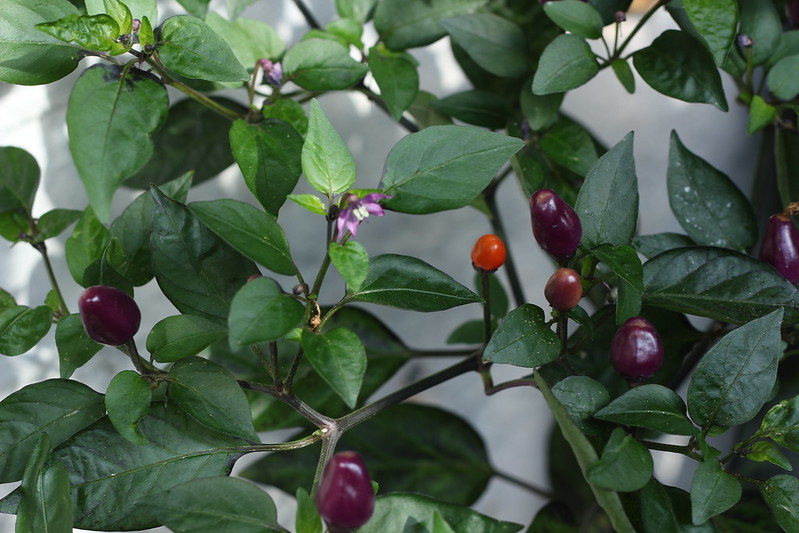 |
| ~ Chilli 'Fairy Lights' ~ |
Tangerine Dream is a relatively mild vegetable chilli while Fairy Lights, being a spice chilli, is considerably hotter, although nowhere near the heat of superhot chillies. When will they be ready to pick? I have no idea! I'm not sure that I want that day to come as these plants are a joy to behold at the moment. Fairy Lights is currently gearing up to transform its fruit from purple through yellow into red - the colours during this change are sublime.
 |
| ~ Chilli 'Thai Green Curry' ~ |
The chilli that I grew myself from seed this year is Thai Green Curry (also from Sea Spring Seeds); It's another mild vegetable chilli but has long slim pods. I sowed the seeds just after I bought the other two plants so Thai Green is less developed than those. At the moment there's only one chilli pod but lots of flowers so I'm hoping for more. This is not such a pretty plant but may well be more useful. It will be good to have a choice for once - surely the whole point of growing your own!
Growing notes: (What worked for me)
Buy small or sow early indoors (mid-February)
Pot on into 10 litre pot when plant is about 3 inches tall. Be careful not to handle the stem.
Use good multi purpose compost; mix in added fertilizer, eg chicken manure pellets
Water when top 2 inches of soil in the pot feels dry.
Give a boost by watering in additional plant food, eg, liquid seaweed.
Grow in a mild sheltered environment - next to a sunny house wall is ideal.
Both of the purchased chillies have been very sturdy healthy plants that have grown steadily. I followed the advice given by Sea Spring Seeds at purchase and repotted the plants into their final 12 litre pots using good compost (Dalefoot peat free) with added chicken manure pellets. They've been fed when I remember (but not more frequently than weekly) using either Tomorite, liquid seaweed or even orchid food added to the watering can; all promote flowering and fruiting. I watered when the soil felt dry at a couple of inches depth. I didn't move them on from 12 litre pots because, with three chilli plants growing, that's all I have room for on the balcony. Even so, the plants are a good chunky size.
Labels:
Chilli,
growing chillies,
Sea Spring Seeds
Posted by
Caro
at
19:20
9 Aug 2016
Love me Tendril - growing broad beans
Have I mentioned that I did a double sowing of broad beans this year? It was an experiment on several levels: I wanted to see if I could successfully extend the broad bean harvest with two sowings, and this second sowing was also a trial of Marshall's Seeds Red Epicure beans which they kindly sent me.
Just over two months later, I'm very pleased with the results. I have a second crop of beans. The seeds were sown direct in mid-May, every one germinated within a couple of weeks and the plants grew strongly. There were no pests (the benefit of late sowings) and the plants quickly matched the first sowing in height. The flowers were as expected (white/black) and prolific, the promise of many pods to come. Which they did. I picked a few at the finger pod stage; those tiny beans, eaten straight from the pod, were delicious - on a par with, if not surpassing, my favourite Karmazyn beans. The mature pods are beautifully shiny and bright green, the beans inside shiny skinned like little red conkers. The skins allegedly stay red when lightly steamed but I'll be skinning them for a summer salad or a bowl of Bean and Mint hummus.
I'll definitely be growing these again next year, especially now I have the allotment space to grow a lot more - who wouldn't love the look of pink beans to brighten a plate of food!
Just over two months later, I'm very pleased with the results. I have a second crop of beans. The seeds were sown direct in mid-May, every one germinated within a couple of weeks and the plants grew strongly. There were no pests (the benefit of late sowings) and the plants quickly matched the first sowing in height. The flowers were as expected (white/black) and prolific, the promise of many pods to come. Which they did. I picked a few at the finger pod stage; those tiny beans, eaten straight from the pod, were delicious - on a par with, if not surpassing, my favourite Karmazyn beans. The mature pods are beautifully shiny and bright green, the beans inside shiny skinned like little red conkers. The skins allegedly stay red when lightly steamed but I'll be skinning them for a summer salad or a bowl of Bean and Mint hummus.
 |
| Above: 5 weeks after sowing. Red Epicure in first rows in front of Karmazyn at back with pods. |
 |
| 7 weeks after sowing. In flower while Karmazyn beans behind are ready for picking. |
 |
| 10 to 11 weeks after sowing. Pods looking good but leaves have a tiny touch of rust. Solution is to prune the leaves off. |
 |
| Red Epicure beans looking pink in the evening sunlight. |
I'll definitely be growing these again next year, especially now I have the allotment space to grow a lot more - who wouldn't love the look of pink beans to brighten a plate of food!
Labels:
beans,
broad beans,
double sowing,
growing
Posted by
Caro
at
16:11
8 Aug 2016
Full of beans! Want an easy recipe for Broad Bean + Mint Hummus?

Did you know there's a whole web page dedicated to bean words? I came across it seeking inspiration for this post title; let's face it, there are only so many ways you can sell a post about beans! My favourites? (and I will try and work these into future posts) Clan of the Cave Bean, Love me Tendril and The Unbearable Lightness of Bean. No? Alright, then.
But I digress... When the pods get too big or I have too many broad beans, instead of just freezing the pods, I dig out this recipe; it's quick, easy, delicious. If I ever get time to loaf around with a glass of wine/beer/gin (not in the same glass or even sitting) one warm balmy evening, this would be the perfect accompaniment, dipped into with some flatbreads, pitta or other dippers of choice. I mean, why buy supermarket hummus when you can easily make your own - and even better if the veg has come from your own patch! I found the results good enough to justify growing beans just for this purpose. I do love my snacks.
 |
Have I mentioned that I did a double sowing of broad beans this year? It was an experiment on several levels: I wanted to see if I could successfully extend the broad bean harvest with two sowings, and just over two months later, I'm very pleased with the results. I have a second crop of beans.
The seeds were sown direct in mid-May, every one germinated within a couple of weeks and the plants grew strongly. There were no pests (the benefit of late sowings) and the plants quickly matched the first sowing in height. Bonus beans that feed the soil with nitrogen ready for the pot grown winter brassicas to be planted once the beans are cleared.
 |
| Above: 5 weeks after sowing. Red Epicure in first rows in front of Karmazyn at back with pods. |
Labels:
broad beans,
Hummus,
Karmazyn,
Mint,
Recipe,
Red Epicure
Posted by
Caro
at
16:45
4 Aug 2016
Rain stopped play (again)
Is it summer - or have I missed it? The school holidays, which will always equate with summer in my mind, have just begun and yet it feels as though the garden is almost at its autumn crescendo. Flowers are starting to fade and yet veg (beans, courgettes, broccoli, beetroot) are just getting going - admittedly, that one is down to me sowing late. I have only a few precious hours each week to spend in my garden and the roller coaster weather has not been conducive to gardening when time allows.
However, last Monday I found myself with an unexpected day off, a day to myself that I immediately earmarked for gardening. It was the best possible way to start the week - I wish every week could be like that! With one eye on the weather (rain forecast for mid-afternoon), I had firm intentions of potting up some seedlings and planting out a few pots intended to fill gaps left by summer plants having done their thing.
At least that was the original plan. As soon as I got into the garden I noticed plants needing deadheading (geums, calendula, leucanthemum, centaurea, sweet peas), plants needing bringing under control (nasturtiums, oregano, horseradish) and plants needing tying in (asparagus ferns, more calendula, scabious). This is the garden tidying that I usually do in early September, if memory serves. The overall look of the garden is currently at the forefront of my thoughts as I rashly entered into Camden in Bloom again a couple of weeks ago. There was one evening when the garden was looking awesomely lovely and I rushed to get an application form in. Naturally, it's all gone to pot since. There's no news yet as to who might have been shortlisted but, if I get through again, I'm considering telling the panel not to bother coming over.
 |
| ~ the garden looking quite spanking a few weeks ago, ie before my Camden in Bloom application ~ |
As I was on a roll with my garden tidying, I also had a go at the raspberries. So far, it's not looking like a brilliant year for raspberries (historically, I pick regularly from early July, even though they're autumn raspberries) so I decided to cut out the weak spindly stems, water and mulch. Leaves on some canes were yellowing - possibly inter-veinal chlorosis (a sign of magnesium deficiency in older leaves) or possibly due to the soil having become baked dry (clay soil) or even lack of water in this stop/start summer we're having. I'd read that raspberries like a slightly acid soil and I had a bag of Dalefoot Ericaceous Compost in reserve so plonked a bit of that around the canes and let the forecast rain water it in.
It's incredible how much can be achieved with a deadline (rain showers) looming. In the end, though, I didn't get any planting out done but managed to get a several bags of green waste to the recycling centre before the rain started and afterwards returned to send a host of snails flying over the railway fence as they celebrated the damp weather by making a beeline for my plants. All in all a very satisfying day.
And, for the record, here's where I'm at with the food growing in early August:
There's also achocha, chard, broccoli, radishes, baby kales and, hopefully at some point soon, tomatoes and spinach.
The weather's cheered up slightly since Tuesday's downpours so, in hindsight, maybe this summer isn't so bad after all! How's everyone else feel about this summer? Just about on target or lagging behind? Things seem to be different all over the country!
Labels:
Veg garden
Posted by
Caro
at
23:34
Subscribe to:
Posts (Atom)

